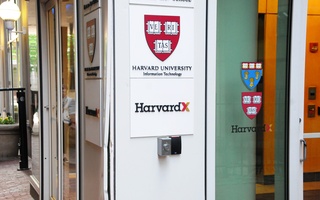Connecting students around the world through high-tech monitors, the HBX Live studio has begun operating, and administrators are eager to support further development of the online service.
As part of HBX—the Business School’s online learning platform—HBX Live was added to the school’s digital learning repertoire in August with the goal of replicating the typical classroom experience.
{shortcode-67ae87c50495260ae20fc6c7d8e83eb364900811}HBX Live is housed in the WGBH public broadcast studio in Brighton. The space is custom designed with a high-resolution video wall that mimics the amphitheater seating style of a traditional Business School classroom.
So far, school affiliates have only used the HBX Live studio for “sessions,” including test runs with alumni, according to Michael P. Soulios, the senior production engineer and operations manager for HBX.
Business School Dean Nitin Nohria said the school began its foray into virtual education “three years ago with this question of what a completely different online experience would look like.”
“Our goal from the beginning was to have people feel as engaged as they do in our case method classes,” Nohria added. He said HBX is one of the areas he hopes to further invest in with funds from the Business School’s capital campaign.
The studio-based HBX Live and HBX CORe, the Credentials on Readiness program which serves as the online platform, are the two main components of HBX. HBX CORe does not have the same synchronous conversation or interaction that characterizes HBX Live.
According to HBX faculty chair Bharat N. Anand ’88, the goals of these two programs are very different.
“The Live studio is essentially saying: can we recreate this classroom discussion environment in a space where you collapse geography, where the only difference is that you don’t need the sixty people sitting right there with you in the room?” he said.
Anand added that HBX Live aims to recreate the “high energy and intensity” that exists in the classroom. It was first developed as a course for MBA students who wanted to brush up on introductory business skills before arriving on campus, according to Anand.
The course has since spread to undergraduates at several universities, as well as a variety of non-students who are simply interested in a primer on business.
Soulios tells faculty in the studio to not worry about the cameras or the podium, but rather to walk around and teach normally.
“Probably the hardest thing to simulate is that feeling of walking in and having all the cameras on you because it’s so visually arresting. But it just takes a few minutes to get used to,” he said.
Moving forward, Anand said he hopes to help develop specific programming for HBX Live, such as courses that span a certain amount of weeks.
“I think we’re closer to the starting point than the finish line,” he said.
Students can enroll in CORe for a fee, but undergraduates or graduates on financial aid can request to have their demonstrated need sent to the Business School for compensation up to 90 percent, according to Anand.
“It is a win-win,” he said. “For the students, of course, but also for us because we get to partner with other universities.”
–Staff writer Julia E. DeBenedictis can be reached at julia.debenedictis@thecrimson.com. Follow her on Twitter @Julia_DeBene.
Read more in University News
Grappling with Campus Sexual Assault, Harvard Looks to Expand Prevention EffortsRecommended Articles
-
 HBX Will Open Online Introductory Courses to Students Worldwide
HBX Will Open Online Introductory Courses to Students Worldwide -
HBX Launches Agreement with AmherstHarvard Business School will reserve a set number of spots for Amherst College students applying to its online Credential of Readiness Program, as well as provide more financial aid opportunities for those applicants, starting in June.
-
HBS Looks To Replicate Classroom with New Online InitiativeHBX Live classrooms will exist entirely online and in real time. In a custom-designed WGBH studio, a high-resolution video wall mimics the amphitheater-style seating of a Business School classroom.
-
 Anand Named Vice Provost for Advances in Learning
Anand Named Vice Provost for Advances in Learning -
 Online Education Program HBX Rebrands as ‘Harvard Business School Online’
Online Education Program HBX Rebrands as ‘Harvard Business School Online’













